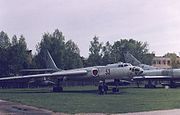
Raduga KSR-5
Encyclopedia


Cruise missile
A cruise missile is a guided missile that carries an explosive payload and is propelled, usually by a jet engine, towards a land-based or sea-based target. Cruise missiles are designed to deliver a large warhead over long distances with high accuracy...
and anti ship missile developed by the Soviet Union
Soviet Union
The Soviet Union , officially the Union of Soviet Socialist Republics , was a constitutionally socialist state that existed in Eurasia between 1922 and 1991....
.
It was essentially a scaled down version of the Raduga Kh-22
Raduga Kh-22
The Raduga Kh-22 is a large, long-range anti-ship missile developed by the Soviet Union. It was intended for use against US Navy aircraft carriers and carrier battle groups, with either a conventional or nuclear warhead.-Development:...
'Kitchen', built to be carried by the less capable Tu-16.
Variants
The Raduga KSR-5 was developed in variants to be deployed as a land attack missile and an anti-ship missile. The missile was designed to be fitted with either a conventional or nuclear warhead.Operational history
The Raduga KSR-5 was deployed aboard such Soviet aircraft as the Tupolev Tu-16Tupolev Tu-16
The Tupolev Tu-16 was a twin-engine jet bomber used by the Soviet Union. It has flown for more than 50 years, and the Chinese license-built Xian H-6 remains in service with the Chinese air force.-Development:...
in Tu-16K-26, Tu-16KSR-2-5, and Tu-16KSR-2-5-11 variants.
Post 1991 with the retirement of the Badger, the KSR-5 warstock was converted into supersonic targets.
Specifications
- Length: 10 m (35 feet)
- Wingspan: 2.5 m (9 feet)
- Diameter: 0.9 m (3 feet)
- Launch weight: 4,000 kg (8,800 lbs.)
- Speed: Mach 3.5
- Range: 300 - 700 km (185-435 miles)
- Guidance: Active radar or anti-radar homing
- Warhead: 1000 kg (2,200 lbs.) high explosive or 350 kT nuclear

